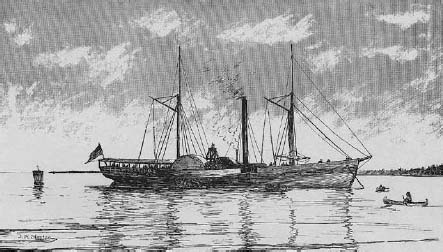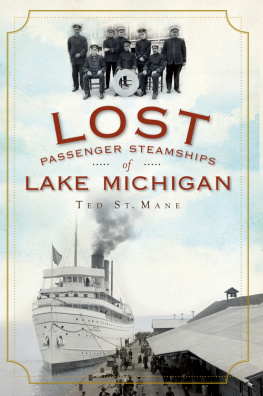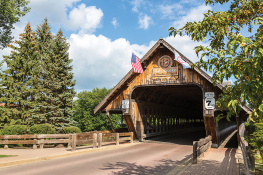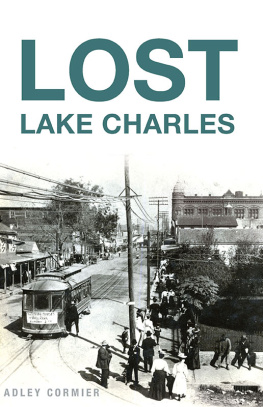

T ED S T . M ANE

Published by The History Press
Charleston, SC 29403
www.historypress.net
Copyright 2010 by Ted St. Mane
All rights reserved
Front and back cover images: Courtesy of the author and the Library of Congress.
First published 2010
e-book edition 2011
ISBN 978.1.61423.215.5
Library of Congress Cataloging-in-Publication Data
St. Mane, Ted.
Lost passenger steamships of Lake Michigan / Ted St. Mane.
p. cm.
Includes bibliographical references.
print edition ISBN 978-1-59629-942-9
1. Inland water transportation--Michigan, Lake--History. 2. Passenger ships--Michigan, Lake--History. 3. Lake steamers--Michigan, Lake--History. 4. Fires--Michigan, Lake--History. 5. Disasters--Michigan, Lake--History. 6. Shipwrecks--Michigan, Lake--History. 7. Michigan, Lake--Description and travel. 8. Michigan, Lake--Navigation--History. 9. Michigan, Lake--History, Naval. I. Title.
HE630.M5S7 2010
917.7404--dc22
2010022981
Notice: The information in this book is true and complete to the best of our knowledge. It is offered without guarantee on the part of the author or The History Press. The author and The History Press disclaim all liability in connection with the use of this book. All rights reserved. No part of this book may be reproduced or transmitted in any form whatsoever without prior written permission from the publisher except in the case of brief quotations embodied in critical articles and reviews.
C ONTENTS
P REFACE
Lake Michigan is one of five freshwater lakes located on the border of the United States and Canada known as the Great Lakes. From east to west, the Great Lakes are Ontario, Erie, Huron, Michigan and Superior. Together they form the largest group of freshwater lakes on Earth. Lakes Michigan and Huron are, in terms of hydrology, a single lake with the same surface elevation, connected by the Straits of Mackinac.
The history of passenger steamship travel on Lake Michigan is inseparable from that of travel on the Great Lakes as many of the steamer routes passed among the lakes. In fact, the linking of the Great Lakes, via river improvements and canals, into one great waterway was an extremely important achievement in promoting westward expansion of the United States in the nineteenth century.
Within this work, a great number of direct quotes from publications and personal accounts of travel have been included in order to give a clear sense of the experiences and conditions on Lake Michigan during the era of passenger steamships. Unusual, British or period spellings and grammatical usages have been left unaltered within quotations.
The terms steamer, steamship and steam boat are used interchangeably within the text and quotes of this book. While in naval terms, a boat is a craft small enough to be carried aboard another vessel, the Great Lakes have spawned their own rules with the steamers of the lakes being commonly referred to as both ships and boats.
A CKNOWLEDGEMENTS
The author would like to gratefully acknowledge the assistance of the many people and organizations that contributed information and shared resources to make this book possible. Among them are numerous historic preservation enthusiasts, archivists and organizations throughout the Great Lakes region that have worked diligently to preserve important records of our collective past. Histories like this one would be impossible if not for the historical documents that were recorded as current events by a long succession of newspapers and other publications. Additionally, earlier histories of the regionmost published prior to 1900have provided invaluable information for this book. Of particular importance to this project were the resources of the Library of Congress, the Department of the NavyNaval Historical Center, Bowling Green State University and my personal collection of passenger steamer histories and images, which have been contributed to by a number of generous collectors over the years.
C HAPTER 1
V ANISHED I NDUSTRY
Fifteen Steam-boats make a mile: this is a new rule of arithmetic, only found out in America, and I mention it because it is much more easy than to remember that they are three hundred and fifty feet long each.
Thomas Horton James, 1845
There was once a flourishing passenger steamship industry on the Great Lakes characterized by grand vessels steaming majestically along deeply wooded shorelines, past emerald isles and across the deep turbulent waters of Americas inland seas. This industry has regrettably all but vanished and is today mostly recalled through stories, images and other relics. In extreme limits the use of passenger steamships on Lake Michigan can be expressed as the years between 1821 and the present, as the steamship Badger still plies the waters of Lake Michigan between Manitowoc, Wisconsin, and Ludington, Michigan, carrying automobiles and passengers much as she has since 1953. However, the robust years of passenger steamship travel on Lake Michigan make a smaller span. This era may be best described as the 110 years between the 1830s and the 1940s when numerous steamships regularly plied the waters of Lake Michigan carrying passengers and cargo. Even this estimation is generous, as the decline of the Lake Michigan passenger steamer became almost epidemic as early as the Great Depression of the 1930s.
The first passenger steamship to venture onto the waters of Lake Michigan was called Walk-in-the-Water, a side-wheel paddle steamer built for the Lake Erie Steam-Boat Company. The ship was powered by a single low-pressure steam engine designed by Robert Fulton while also equipped with two schooner-rigged masts. Her usual route, carrying passengers and cargo, was across Lake Erie between Buffalo, New York, and Detroit, Michigan, and later between Detroit and Mackinac Island at the northern end of Lake Huron.

This illustration by Samuel Ward Stanton shows Walk-in-the-Water, which was the first steamship on Lake Michigan. Courtesy of the Library of Congress.
Launched at Black Rock, New York, on August 23, 1818, Walk-in-the-Water had already been in service for nearly three years when on July 31, 1821, she left Detroit on a thirteen-day, 1,200-mile round-trip journey that took her through the Straits of Mackinac and across Lake Michigan to deliver a cargo of general merchandise and 200 passengers to Green Bay, Wisconsin.
While Walk-in-the-Waters journey initiated steamer navigation on Lake Michigan, it did not lead to an immediate boom in steamship traffic on the lake. Walk-in-the-Water herself was caught in a storm and driven ashore near Buffalo less than twelve weeks after her only trip to Lake Michigan. The ship was too badly damaged to be saved, and Green Bay did not receive another steamship visit until four years later with the arrival of the












